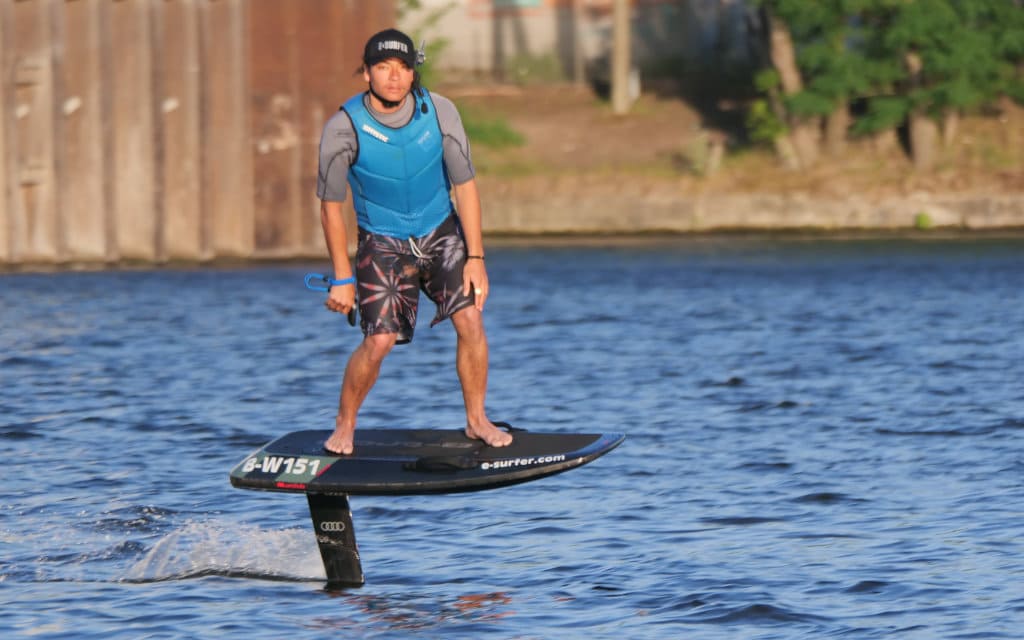Why are eFoils so expensive? Here you can read the hard facts about materials, batteries, jet vs. prop, IP protection, CE/RED, service, and real market prices.
Want to know why a good eFoil can easily cost five figures? The short answer: high-quality materials, complex technology, elaborate safety features, low production numbers, and reliable service drive up the price.
You can read the long answer here. No sugarcoating. With a look at what has proven itself in decades of water sports. There are reasons why branded eFoils are so expensive.
We have also produced a video for the E-SURFER YouTube channel about why eFoils are so expensive:
The problem with buying: When you're just starting out with eFoiling, you're so busy with the learning curve that even during a test drive, you can't immediately tell the difference between premium eFoils and cheaper models from China or Eastern Europe. At first, the feeling of taking off is amazing!
But once you've gained a little experience, you'll start to feel the differences. Of course, a five-figure purchase price is a significant investment, and many people ask themselves, “Will I even use it?” We wrote an article on this topic called “Does eFoiling get boring?”
Premium eFoil brands such as Aerofoils, Lift Foils, and Fliteboard cost around 16,000 EUR including 19% German VAT when configured correctly. In this article, we will try to explain why foils are so expensive and why an eFoil that costs half or even a third of the price should be treated with caution.
The board – better carbon
Carbon costs money. Cheaper alternatives cost you riding experience
The first eFoils relied on full carbon. Little has changed in the high-end sector to this day. Carbon is very stiff and lightweight. This results in early lift-off, precise edges, and a direct riding experience. However, carbon is more expensive than GRP. Significantly so. The manufacturing process is complex and the raw fiber is expensive. This can be seen worldwide in aviation, motorsports, and high-end bikes.
Cheaper boards use GRP, inflatables, or EPP/foam solutions with frames. This saves on material costs. You pay for this with sluggishness, less precise rails, and spongy cornering. On smooth water, this is hardly noticeable at first. But as you gain experience, it becomes more apparent. That's why premium brands continue to rely on carbon decks and assemblies. Prices for pure board shells in the premium segment are sometimes in the upper four-digit range, with complete setups significantly higher.
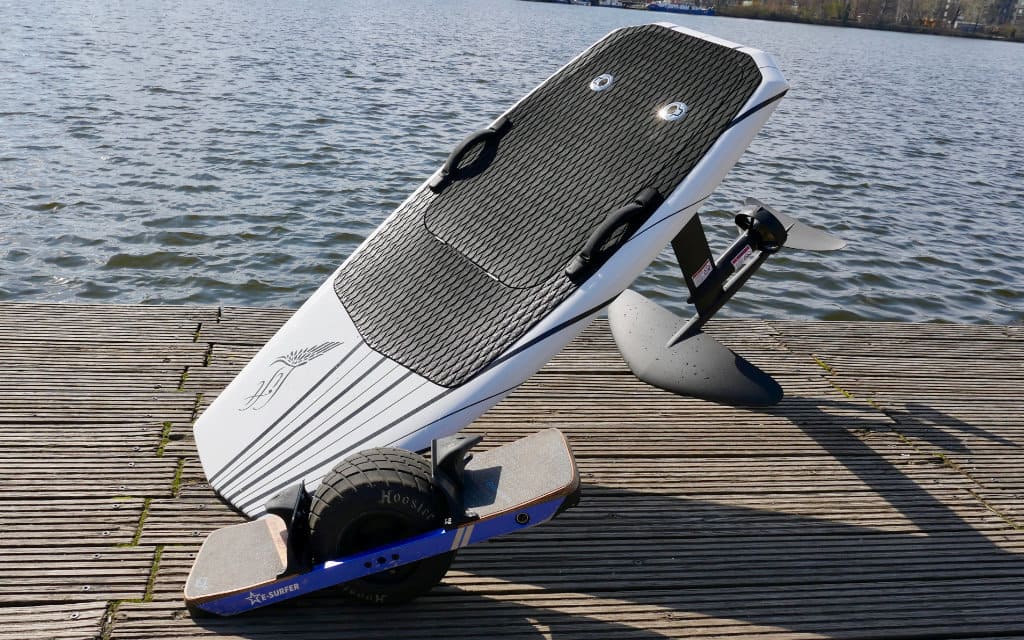
The board has to withstand high bending and torsional forces as well as impacts in the water, so it needs reinforced mast mounts, robust deck layers, and reliable sealing. These material choices and the careful manufacturing process make eFoils so expensive, but they ensure stability, efficiency, and long durability.
Differences in board materials:
- Inflatable: Inflatable boards are made of drop stitch fabric with multiple layers of coating. The high internal pressure creates stiffness in the surface, but the torsional stiffness remains lower than that of composite boards. The surface is flexible and forgives contact, which is pleasant for beginners and transport. The weight is usually low, the pack size is small, but the setup is tedious. On the other hand, the riding characteristics on the water are not very good. The blunt material creates more resistance when taking off and landing, and the lack of hard edges makes turning and control on the surface difficult.
- Carbon fiber composite: Carbon fiber-reinforced boards are very stiff and lightweight. The high bending and torsional stiffness results in a direct, precise riding experience and good efficiency in the water. The board responds very precisely to edging and course changes, even at higher speeds and in choppy water. Carbon is more expensive in terms of material and manufacturing. That's why carbon eFoils are so expensive.
- Fiberglass composite: Fiberglass boards are mid-range, but with clear compromises. Compared to carbon, they are heavier and less rigid, the riding experience is softer and the response is noticeably less direct, especially at higher speeds and in tight radii. The gliding performance and precision in carving are lower, and more force is required for the same maneuvers. Compared to inflatables, they are more dimensionally stable, but less forgiving on impact and more cumbersome to transport. The lower price is a positive, but the disadvantages are the higher weight, lower stiffness, and greater susceptibility to dents and paint damage.
- Foam core: The foam core provides buoyancy and shape, but it does not determine the stiffness alone. Rigidity and durability are provided by the composite layers of fiber and resin as well as local reinforcements. Higher foam densities improve pressure and impact resistance but increase weight. Critical areas are the mast socket, standing area, and edges, which are additionally reinforced. Some foam models absorb water and can weigh 2-3 kg more after use until they dry again.
- Comparison: Inflatable offers a soft surface and easy handling during transport. Carbon fiber composite provides maximum stiffness and precision for sporty riding and high efficiency. Fiberglass composite offers a good compromise between durability, cost, and a comfortable riding experience. The foam core is the basis for volume and shape, while the composite layers determine how stiff and responsive the board ultimately is.
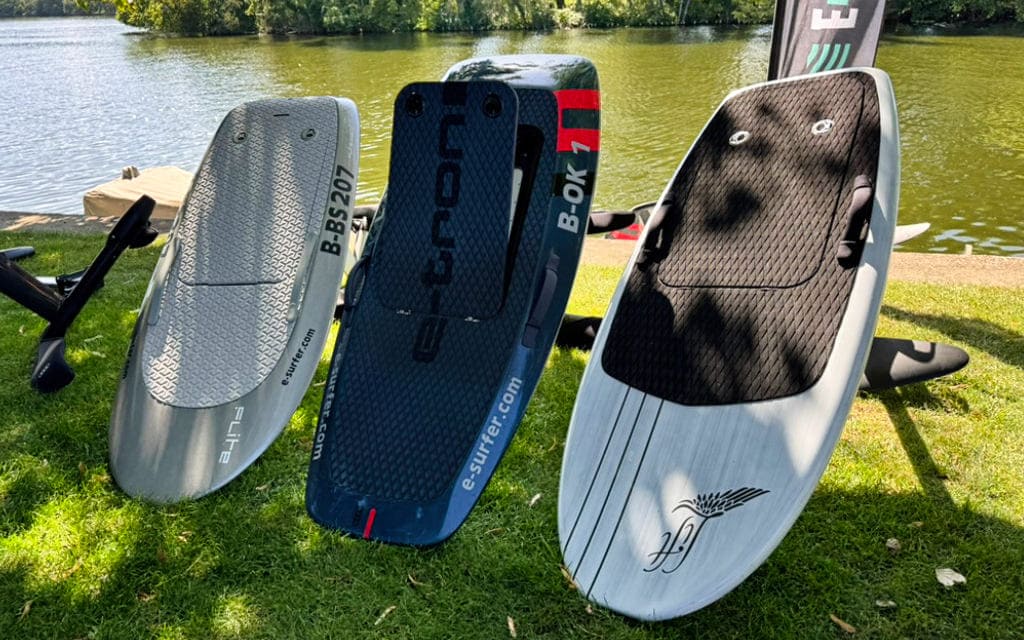
Mast and fuselage: Rigidity is control
Longer and stiffer masts allow for steeper turns, keep you calmer in choppy water, and provide more precise transmission. Carbon masts are lighter and stiffer, but more expensive than aluminum. Many systems offer both options. If you carve aggressively, you will feel the difference immediately. Those who cruise comfortably will notice it later, but it is there. The difference in materials explains the extra cost.
Lift Foils and Aerofoils already use 80 cm carbon masts in their basic configurations. And carbon is what makes eFoils so expensive.
The connection between the mast, fuselage, and wing must be a precise fit and corrosion-resistant so that forces are transmitted safely, which requires a lot of know-how and time.
Propulsion: Jet is safer and more expensive
eFoils became popular with propellers. The first eFoils all had a propeller. It wasn't until 2022 that Aerofoils launched the first jet propulsion for eFoils. Since then, other manufacturers have also launched jet propulsion systems. Today, we recommend jets for most riders.
The reason is simple: no exposed propeller means less risk of injury. Manufacturers advertise jet systems for exactly this reason. Accidents involving the propeller are rare, but they do happen. Mostly to beginners and, in the worst case, to children. So why take the risk of getting your fingers or toes caught in the propeller? For most eFoiler riders, there is no reason except to save money. The exception is experienced, aggressive eFoilers who want the pressure of the propeller or need a folding propeller to ride waves.
Jets are slightly less efficient and have less punch. For 80-90% of riders, this is irrelevant and safety prevails. In addition, the jet accelerates and brakes more smoothly, which many find more comfortable.
Sporty riders stick with the propeller. The market reflects this. Propeller drives are mainly found on inexpensive eFoilsand on the super sporty models from Lift Foils and Fliteboard.
So the safe jet drive is another reason why eFoils are so expensive.
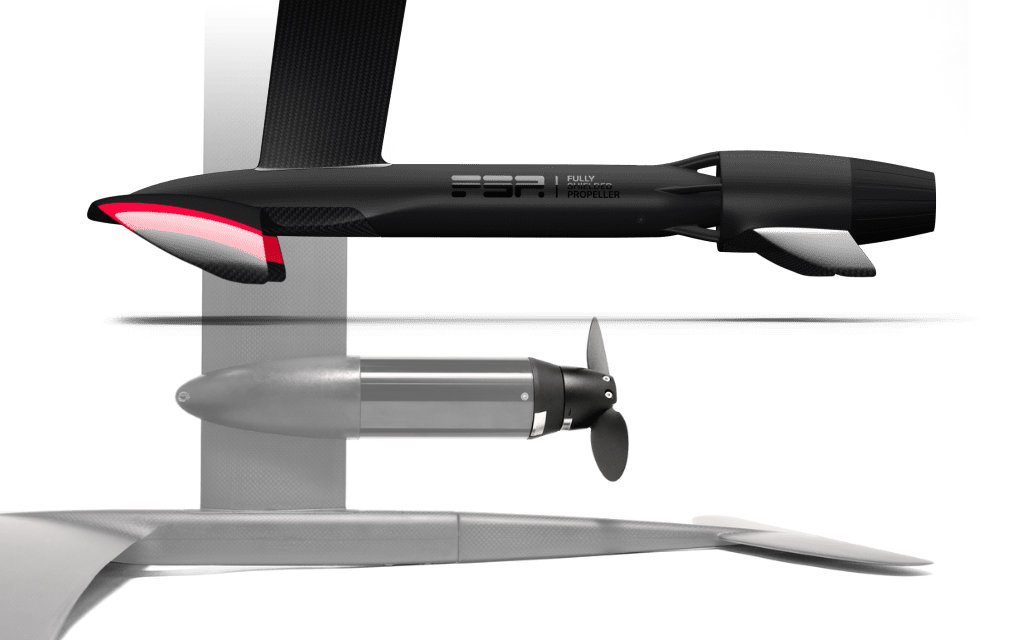
The jet-based propulsion system from Aerofoils, for example, is fully enclosed and integrated into the fuselage in a way that promotes good airflow. There are no exposed propeller blades, which reduces the risk of injury and entanglement. The design requires a precise impeller, a suitable nozzle, and a compact high-performance motor. The components must be manufactured with tight fits and permanently sealed against salt water.
Each unit is tested for function, tightness, and durability. The additional development effort and testing make eFoils expensive, but they deliver noticeable safety and robustness.
Battery and BMS: Cell quality, software, and standards
The battery is the most expensive single component. It determines range, power output, and service life. The nominal Wh rating alone is not the decisive factor. The following are important:
- Cell quality (brand-name cells, tight tolerances).
- BMS logic: How is charging, discharging, balancing, cooling, and monitoring performed?
- Safety reserves: Premium BMS deliberately limit the charging window to protect the cells.
- Certifications and tests, e.g., UN 38.3 for the transport of lithium batteries.
- UN 38.3 is mandatory for almost all lithium batteries in transport
Tests include shock, vibration, thermal, vacuum, short circuit, and overcharge. This costs time and money, but reduces risk. Reputable suppliers provide test documents. All this makes an eFoil so expensive.
Specific data helps with classification: Fliteboard specifies ~1.6 kWh for the Flitecell “Sport” and ~2.1 kWh for the “Explore,” ~2.1 kWh, with typical foil times depending on the setup. Lift specifies around 2.2 kWh and approximately 90 minutes of on-power ride time for Gen5. Aerofoils specifies 2.1 kWh and up to 2 hours of range for the Endurance battery. These values vary depending on rider weight, wings, water conditions, and jet vs. prop.
So you should choose a battery with around 2.1 kW to achieve a realistic range of 1.5 hours.
A large battery from premium manufacturers costs around EUR 4,000. So how is it possible that low-cost eFoil manufacturers can offer complete boards for EUR 5,000 to 6,000? Safe batteries come at a price, which is why, as has been said many times before, premium eFoils are so expensive.
Chargers: Communication protects batteries and extends their service life
Good chargers communicate with the BMS (battery management software in the battery, e.g., via CAN). They do not start if the battery is too hot, adjust charging profiles, and adhere to limit values.
Industrial brand chargers such as Delta-Q are widely used in e-mobility and are designed for demanding profiles. This is not a cosmetic feature. It prevents cell stress and consequential damage. Premium chargers cost significantly more than no-name power supplies. Such a power supply alone costs approx. 1,200 EUR, which is one reason why eFoils are so expensive.
But these high-tech power supplies not only increase the service life of the eFoil battery, they also serve above all for safety. In the worst case, an uncontrolled eFoil battery could lead to a fire.

Wings: Hydrodynamics is hard work, not a copying exercise
Front and rear wings determine starting speed, stability, carving radius, and efficiency. You may not notice this on your first test ride, but you will definitely notice it later.
Good profile design requires experience, simulation expertise, and many prototypes. Premium manufacturers have been iterating for years on a large wing portfolio for different riding styles.
That's development time that's reflected in the price. Cheap copies often don't fit neatly into the system and ride unbalanced. Premium manufacturers invest an enormous amount of time in developing and testing wings. Nothing has more influence on riding performance. This development time requires a lot of resources and makes premium eFoils so expensive.
It's easy to do a 3D scan and copy a wing, but that doesn't mean it will fit the rest of the setup.
Premium wings are made of high-quality composite laminates of carbon fiber and fiberglass. The wings with front wing and stabilizer are made of high-strength carbon fiber composite with precisely laminated profiles, smooth surfaces, and tight tolerances for clean water separation. This is what makes premium eFoils so expensive.
Remote control: Information density increases safety and control
A color display with clear indicators for speed, battery status (board and remote), error messages, and modes seems like a luxury. In practice, it helps you make decisions faster.
This reduces beginner mistakes and protects equipment. Premium remotes are correspondingly more expensive, especially since they also have to pass sealing, radio certification, and EMC tests.
People who wear reading glasses (like me) particularly appreciate a large, high-contrast color display. This is especially true when eFoiling on the water, but also on land: there are now so many settings in the hand controllers that a small black-and-white display quickly becomes confusing.
This is another reason why eFoils are so expensive.
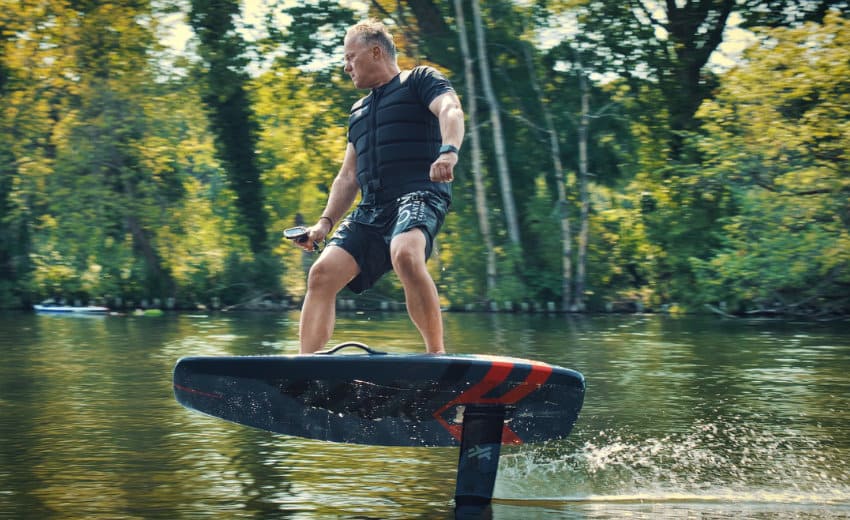
Sealing and standards: IP protection, CE/RED, EMC, radio
eFoils are electrical systems in salt water. Seals, vents, encapsulation, connectors, and corrosion protection determine service life. That is why manufacturers pay attention to high IP protection classes for housings and components. IP67 stands for dustproof and temporary submersion up to 1 m. IP68 allows longer or deeper submersion according to the manufacturer's specifications. This involves technical effort and testing.
Radio remote controls are subject to the Radio Equipment Directive (RED) in the EU. In addition, there are EMC requirements according to the EN 61000 family. CE conformity means testing, documentation, and, if necessary, notified body expenses. This also ends up in the unit costs and makes eFoils so expensive.
Low quantities: No real mass production
eFoils are a niche market. Small series have inefficient unit costs: tools, molds, manual laminating time, CNC milling, final assembly, end-of-line testing. All these things, which are for your safety, make eFoils so expensive.
Market reports estimate the segment to be in the low to mid three-digit million range worldwide. That is a long way from volumes that would drastically drive down prices.
Reliable service: Spare parts, training, workshop
After-sales is expensive. Warehousing for wings, masts, seals, electronics. Training of technicians. Warranty claims. Fast response times during peak seasons. Premium brands factor service costs into the product price. This is one reason why eFoils are so expensive.
Dealers with workshops ensure turnaround times. This is worth its weight in gold in summer. You can reach us seven days a week via WhatsApp and we ship spare parts by express delivery throughout Europe. Even during the holidays. If you buy directly from manufacturers, you will have no contact person after 4 p.m. on Friday.
Some low-cost suppliers do not even have spare parts in stock in Europe. This means you may have to wait six weeks for components to arrive from China. A disaster given our short summers.
What does “good” actually cost? Examples from Europe
- Aerofoils - Audi e-tron eFoil: from around €14,269 depending on the set and battery. With the large battery (recommended) and the right charger, €15,769 in full carbon.
- Lift Foils: Complete sets in the premium range. Lift Foils makes no compromises and offers full equipment. Large battery, premium power supply, and full carbon for €15,999.
- Fliteboard: Entry-level models with cheaper AIR variants starting at around €6,700 according to the manufacturer, up to special editions costing over €20,000. Boards, masts, and batteries are configured. Fliteboard is very creative with its pricing. In my opinion, it's sometimes dubious. I recorded this video about it:
If the video does not jump to the right place, you can see the Fliteboard pricing from minute 4:37 or the chapter “Price differences between Flite & Lift.”
Why aren't prices falling quickly?
eFoils are so expensive because prices have risen steadily since 2018. While the Lift Foils 2018 in full carbon, with a large battery and premium power supply, still cost EUR 12,000 in 2018, it now costs EUR 16,000, similar to Aerofoils. Fliteboard is even more expensive in the right configuration.
Every manufacturer has raised their prices year after year.
Raw materials are becoming more expensive. Carbon fiber remains a premium material. Lithium cells are in global demand, for example from the automotive industry.
Production volumes are small. At the same time, requirements for radio safety and cybersecurity are increasing within the framework of the RED. All of this prevents price reductions and makes eFoils so expensive.
What should you look for when buying?
- Honest battery data: Wh specification, cell type, BMS functions, UN 38.3 certification.
- Charger: Communication with BMS, established manufacturer, IP rating.
- Board/mast: Carbon where it counts.
- Drive: Jet for safety and family use; prop for very sporty riders
- Wing portfolio: Wings for learning and progression.
- Certification: CE/RED, EMC concept, IP protection.
- Service: Dealer with workshop, parts availability during the season.
All of these factors contribute to the high cost of eFoils.
Realistic expectations: runtime and performance
Manufacturer specifications apply under ideal conditions. In practice, weight, riding style, jet vs. prop, wing, and water level cause significant deviations. Manufacturer specifications provide reference values. Your figures will often be lower if you ride in stronger headwinds or choppy water. Rider weight also plays a major role. Allow for a buffer.
Realistic figures are 1.5 hours of riding and 1.5 hours of charging with the right battery and power supply. Those who race consume more (as with cars). The normal cruising speed is around 25 km/h.
Cheap and affordable eFoils
A word about cheap eFoils, which often come from China or Eastern Europe. I completely understand if someone doesn't have a budget of €16,000, but I would still recommend a used premium eFoil because the riding experience is simply incomparable.
Ultimately, however, everyone has to decide for themselves. If someone is happier with a cheap eFoil brand and wants to take the risk, then so be it. I have personally tested many eFoil brands and models since 2018, and I have not been impressed by the low-budget models. I have witnessed too many failures myself. Not to mention the riding experience.
Over the years, I have seen many cheap eFoil brands come and go. They cannot operate economically, and once a certain number of units have been sold, the system collapses due to the large number of support cases. Unfortunately, it is not uncommon for them to come back under a new name. But what do you do when the company goes bankrupt and neither service nor spare parts are available?
However, the real reason why I am writing this “cheap eFoil” paragraph is a different one. At trade fairs and through customer feedback, I am increasingly hearing that cheaper suppliers are badmouthing premium eFoils.
They claim that premium eFoils are so expensive because premium brands charge for their name. That is not correct. Even Aerofoils is allowed to use the “Audi” brand because Audi AG is an investor and does not have to pay anything for the name.
Hopefully, this article helps to explain that there are reasons why branded eFoils are so expensive.

Why are eFoils so expensive? - Conclusion
Why are eFoils so expensive? Because they have to deliver a lot of high-tech features and safety in a salty environment. Carbon structures, precise drives, tested batteries with intelligent software, communicating chargers, sealed housings, radio and EMC compliance, low production numbers, and genuine after-sales support all add up.
Cheap is always an option. Good lasts longer, performs better, and retains its value. And above all, it is safer.
There is a reason for sayings such as “You get what you pay for” or “If you buy cheap, you buy twice.”
I hope this article has helped to explain why eFoils are so expensive. Perhaps a used premium eFoil is better than a cheap offer.
You can find more information about choosing the right e-foil in our “eFoil buying guide” or in our shop, by phone, or by email. I will be happy to answer any questions you may have about why eFoils are so expensive.
